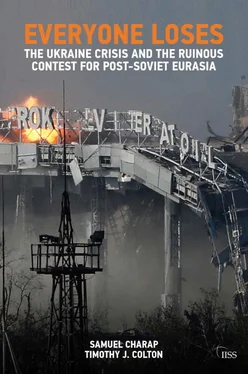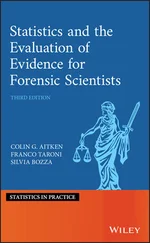But Moscow does not have an authoritarianism-promotion agenda, an analogue to EU and US democracy promotion. Any policy of norm promotion is predicated not only on affirmative preferences but on deployment of the means to achieve them. Russia demonstrates neither. [10] Nelli Babayan, ‘The Return of the Empire? Russia’s Counteraction to Transatlantic Democracy Promotion in Its Near Abroad’, Democratization , vol. 22, no. 3, March 2015, pp. 438–58.
The broader point here is that a simple dichotomy between a West altruistically promoting democratic norms and a Russia deliberately supporting authoritarianism does not match reality. By this period, a three-front regional competition – in geopolitics, geo-economics and geo-ideas – was central to decision-making on both sides .
Moscow’s immediate reaction to the Orange Revolution was relatively mild. Clearly, it was not pleased either by the revolutionary form of political change or by the ascendance of a leadership with an inimical policy agenda. But Putin did not attempt to isolate the Orange leaders. Yushchenko was invited to visit Moscow in February 2005, and Putin reciprocated with a trip to Kyiv the next month, meeting both Yushchenko and Tymoshenko, who seemed to be jostling for his favour. [11] Andrei Kolesnikov, ‘Obnimai, no proveryai’, Kommersant , 21 March 2005.
The presidential meeting produced an agreement to create a Putin–Yushchenko Commission to oversee various mid-level working groups, and approval of a work plan for the year.
The new government in Kyiv did not pull out of Russia’s favoured integration format of the moment, the SES, continuing Kuchma’s approach of protracted talks with minimal firm commitments. At the time, Russia held out the prospect that joining the SES and pursuing European integration need not be irreconcilable. As Putin said during his visit to Kyiv in March 2005, ‘The statement that the SES involves movement in one direction, while cooperation with the EU entails movement in the opposite direction, is totally false.’ He went on to describe the plans for creating the Four Common Spaces with the EU, one of which was a common economic space – ‘essentially, the harmonisation of Russian and EU laws’, as Putin put it. If Moscow and Kyiv work together toward that end, that would ‘create the preconditions’ for Ukraine’s ‘movement toward Europe’. [12] ‘Nachalo vstrechi s prem’er-ministrom Ukrainy Yuliei Timoshenko’, 19 March 2005, http://kremlin.ru/events/president/transcripts/22867 .
Indeed, at that time Russia’s economic coordination with the EU was more advanced than Ukraine’s. The EU had much more of a donor–recipient relationship with Kyiv; a 2004 European Commission report highlights the EU’s status as the largest donor to Ukraine and discusses future integration only notionally. [13] ‘Commission Staff Working Paper – European Neighbourhood Policy – Country Report Ukraine {COM(2004)373 Final}’, 12 May 2004, http://www.enpi-info.eu/library/content/ukraine-enp-country-report .
An analogous Commission document on the relationship with Russia describes a plan to create a shared ‘open and integrated market’ between the two, specifying a range of steps including common standardisation for industrial products, intellectual-property regulation, competition policies and regulatory convergence. [14] ‘Russia – Final Version of the Road Map on the Common Economic Space Agreed at the EU–Russia Summit on 10 May’, 24 May 2005, http://www.enpi-info.eu/library/content/eu-russia-roadmap-common-economic-space .
Yet the Kremlin was not prepared to subsidise a Ukrainian government that was now actively pursuing NATO and EU membership, while only paying lip service to Russia’s integration agenda. World oil prices were hitting new highs at the time, driving up the price European customers paid to Gazprom, the Russian state-controlled energy giant, for natural gas. The real value of the implicit subsidy Russia provided to Ukraine shot up as a result, and with it the opportunity cost of maintaining the practice. By the end of 2005, Ukraine was paying up to four times less for gas than Gazprom’s European customers. [15] Jonathan Stern, ‘The Russian–Ukrainian Gas Crisis of January 2006’, Oxford Institute for Energy Studies, 16 January 2006, p. 6.
Without an incentive to do favours for the new government in Kyiv, the Kremlin was unwilling to order Gazprom to forfeit market prices on exports to Ukraine. During the negotiations over renewal of the supply contract in late 2005, Gazprom accordingly sought to cancel subsidised pricing unless Kyiv agreed to a consortium arrangement for its pipeline network. Kyiv turned Gazprom down, and threatened to divert to Ukrainian consumers gas meant for Europe if no compromise were to be found. On 1 January 2006, Russia interrupted supplies to Ukraine after the deadline had passed; it back-pedalled quickly after Ukraine started siphoning off gas meant for the EU and pressure dropped in several European countries. An arrangement was reached empowering a shady intermediary, RosUkrEnergo, to manage the bilateral gas relationship, which enriched well-connected elites in Moscow and Kyiv alike.
Breathless press coverage at the time portrayed Russia’s actions as the use of gas as a political weapon. The reality was more complex. Ending munificent subsidies can scarcely be portrayed as punishment, and it was unclear what political objective Russia might have been pursuing, besides alienating EU and Ukrainian publics and elites. A more cogent explanation is that Russia was moving to a two-pronged approach to the issue of gas exports to its neighbours: cheap gas only for countries willing to participate in its integration projects and to share ownership of gas assets; unsentimental commercial terms for the rest. In early 2006 only Belarus, which joined every Russia-led grouping and ceded control of its gas monopoly to Gazprom, avoided a price hike.
The first Russia–Ukraine gas war was a demonstration of Moscow’s quickness to resort to economic duress whenever it perceives a neighbour to be misbehaving. More often than not, such tactics have boomeranged. Even when they induced short-term compliance, the long-term cost of loss of trust and goodwill, especially given historically conditioned threat perceptions, outweighed the gains. Russian policy toward the region has rarely taken into account such sensitivities.
Moscow continued its coercive economic diplomacy in the region throughout the subsequent years. The motives, as far as one can divine from the circumstances, ranged from punishment for perceived bad behaviour to strong-arming concessions during unrelated negotiations. Moscow rarely announced its objectives openly, instead airing ludicrous cover stories for public consumption. In 2006 alone, allegations of hygiene violations led to import bans on dairy, meat and poultry products from Ukraine (January); Georgian and Moldovan wine (March); and Georgian mineral water (May). Later that year, in retaliation for the Georgians’ public arrest of four suspected Russian spies, Moscow suspended all transportation links with Georgia, and deported migrant workers amidst what seemed to be a campaign of intimidation against ethnic Georgians in Russia. There were two energy disputes with Belarus in 2006–07, including an oil cut-off. Little by way of grand design seems to have been involved. As Rilka Dragneva and Kataryna Wolczuk note, Moscow had developed a reflex of ‘deploying selective, targeted sanctions toward any states which pursued a policy that Russia regarded as unfriendly’. [16] Rilka Dragneva and Kataryna Wolczuk, Ukraine Between the EU and Russia (London: Palgrave Macmillan, 2015), p. 74.
The tactical goals varied in these scattered episodes. Taken together, the Russian actions did not amount to much, let alone a strategy for regional domination.
Читать дальше











